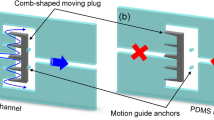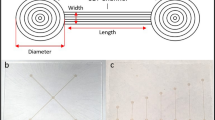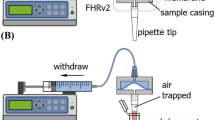Abstract
Microfluidic capillary systems operate using capillary forces only and require capillary pumps (CPs) to transport, regulate, and meter the flow of small quantity of liquids. Common CP architectures include arrays of posts or tree-like branched conduits that offer many parallel flow paths. However, both designs are susceptible to bubble entrapment and consequently variation in the metered volume. Here, we present two novel CP architectures that deterministically guide the filling front along rows while preventing the entrapment of bubbles using variable gap sizes between posts. The first CP (serpentine pump) guides the filling front following a serpentine path, and the second one (leading-edge pump) directs the liquid along one edge of the CP from where liquid fills the pump row-by-row. We varied the angle of the rows with respect to the pump perimeter and observed filling with minimal variation in pumping pressure and volumetric flow rate, confirming the robustness of this design. In the case of serpentine CP, the flow resistance for filling the first row is high and then decreases as subsequent rows are filled and many parallel flow paths are formed. In the leading-edge pump, parallel flow paths are formed almost immediately, and hence, no spike in flow resistance is observed; however, there is a higher tendency of the liquid for skipping a row, requiring more stringent fabrication tolerances. The flow rate within a single CP was adjusted by tuning the gap size between the microposts within the CP so as to create a gradient in pressure and flow rate. In summary, CP with deterministic guidance of the filling front enables precise and robust control of flow rate and volume.





Similar content being viewed by others
References
Akbari M, Sinton D, Bahrami M (2009) Pressure drop in rectangular microchannels as compared with theory based on arbitrary cross section. J Fluids Eng 131:041202
Bracke M, Devoeght F, Joos P (1989) The kinetics of wetting—the dynamic contact angle. Trends Colloid Interface Sci 79:142–149
Cesaro-Tadic S, Dernick G, Juncker D, Buurman G, Kropshofer H, Michel B et al (2004) High-sensitivity miniaturized immunoassays for tumor necrosis factor a using microfluidic systems. Lab Chip 4:563–569
Chapuis O, Prat M (2007) Influence of wettability conditions on slow evaporation in two-dimensional porous media. Phys Rev E 75:046311-1–046311-5
Delamarche E, Bernard A, Schmid H, Michel B, Biebuyck H (1997) Patterned delivery of immunoglobulins to surfaces using microfluidic networks. Science 276:779–781
Delamarche E, Bernard A, Schmid H, Bietsch A, Michel B, Biebuyck H (1998) Microfluidic networks for chemical patterning of substrate: design and application to bioassays. JACS 120:500–508
Delamarche E, Juncker D, Schmid H (2005) Microfluidics for processing surfaces and miniaturizing biological assays. Adv Mater 17:2911–2933
Gervais L, Delamarche E (2009) Toward one-step point-of-care immunodiagnostics using capillary-driven microfluidics and PDMS substrates. Lab Chip 9:3330–3337
Gervais L, de Rooij N, Delamarche E (2011a) Microfluidic chips for point-of-care immunodiagnostics. Adv Mater 23:H151–H176
Gervais L, Hitzbleck M, Delamarche E (2011b) Capillary-driven multiparametric microfluidic chips for one-step immunoassays. Biosens Bioelectron 27:64–70
Groll M, Schneider M, Sartre V, Zaghdoudi MC, Lallemand M (1998) Thermal control of electronic equipment by heat pipes. Rev Gen Therm 37:323–352
Hassanizadeh SM, Gray WG (1993) Thermodynamic basis of capillary pressure in porous media. Water Resour Res 29:3389–3405
Hitzbleck M, Gervais L, Delamarche E (2011) Controlled release of reagents in capillary-driven microfluidics using reagent integrators. Lab Chip 11:2680–2685
Ho C, Ruehli A, Brennan P (1975) The modified nodal approach to network analysis. IEEE Trans Circuits Syst 22:504–509
Hoffman RL (1982) A study of the advancing interface.2. The theoretical prediction of the dynamic contact angle in liquid gas systems. J Rheol 26:606
Juncker D, Schmid H, Drechsler U, Wolf H, Wolf M, Michel B et al (2002) Autonomous microfluidic capillary system. Anal Chem 74:6139–6144
Lee A (2010) VirtualDub. In: VirtualDubMod Surround 1.6.0.0 (ed)
Leverett MC (1941) Capillary behavior in porous solids. Trans Am Inst Min Metall Eng 142:152–169
Lovchik RD, Bianco F, Tonna N, Ruiz A, Matteoli M, Delamarche E (2010) Overflow microfluidic networks for open and closed cell cultures on chip. Anal Chem 82:3936–3942
McNeely MR, Spute MK, Tusneem NA, Oliphant AR (1999) Hydrophobic microfluidics. In: Ahn CH, Frazier AB (eds) Microfluidic devices and systems, vol 3877. Spie-Int Soc Optical Engineering, Bellingham, pp 210–220
Mirzaei M, Pla-Roca M, Safavieh R, Nazarova E, Safavieh M, Li H et al (2010) Microfluidic perfusion system for culturing and imaging yeast cell microarrays and rapidly exchanging media. Lab Chip 10:2449–2457
Parsa H, Chin CD, Mongkolwisetwara P, Lee BW, Wang JJ, Sia SK (2008) Effect of volume- and time-based constraints on capture of analytes in microfluidic heterogeneous immunoassays. Lab Chip 8:2062–2070
Prat M (2011) Pore network models of drying, contact angle, and film flows. Chem Eng Technol 34:1029–1038
Safavieh R, Juncker D (2013) Capillarics: pre-programmed, self-powered microfluidic circuits built from capillary elements. Lab Chip 13:4180–4189
Safavieh R, Zhou GZ, Juncker D (2011) Microfluidics made of yarns and knots: from fundamental properties to simple networks and operations. Lab Chip 11:2618–2624
Seebergh JE, Berg JC (1992) Dynamic wetting in the low capillary number regime. Chem Eng Sci 47:4455–4464
Smith KC (1998) Introduction to electronics. In: KC’s problems and solutions for microelectronic circuits, chap 1, 4th edn, vol 1. Oxford University Press, USA, pp 1–9
Tamayol A, Yeom J, Akbari M, Bahrami M (2013) Low Reynolds number flows across ordered arrays of micro-cylinders embedded in a rectangular micro/minichannel. Int J Heat Mass Transf 58:420–426
Vulto P, Podszun S, Meyer P, Hermann C, Manz A, Urban GA (2011) Phaseguides: a paradigm shift in microfluidic priming and emptying. Lab Chip 11:1596–1602
Weislogel MM (2003) Some analytical tools for fluids management in space: Isothermal capillary flows along interior corners. In: Narayanan R (ed) Gravitational effects in physico-chemical processes, vol 32, pp 163–70
Weislogel MM, Lichter S (1998) Capillary flow in an interior corner. J Fluid Mech 373:349–378
White FM (2005) Solutions of the Newtonian viscous-flow equations. In: Viscous fluid flow, 3rd edn. McGraw-Hill Science/Engineering/Math, pp 116–125
Zimmermann M, Schmid H, Hunziker P, Delamarche E (2007) Capillary pumps for autonomous capillary systems. Lab Chip 7:119–125
Zimmermann M, Hunziker P, Delamarche E (2008) Valves for autonomous capillary systems. Microfluid Nanofluid 5:395–402
Acknowledgments
We would like to acknowledge funding from NSERC, CIHR and CFI, and the assistance of the McGill Nanotools and Microfab Laboratory (funded by CFI, NSERC and Nanoquebec). We also acknowledge Prof. Elizabeth Jones for allowing us to use the facilities in her lab. We also acknowledge Arash Kashi, Mohammad Ameen Qasaimeh, and Mohammadali Safavieh for their helpful discussions. DJ acknowledges the support from Canada Research Chair.
Author information
Authors and Affiliations
Corresponding author
Electronic supplementary material
Below is the link to the electronic supplementary material.
Supplementary material 1 (MP4 3118 kb)
Supplementary material 2 (MP4 2039 kb)
Supplementary material 3 (MP4 2008 kb)
Supplementary material 4 (MP4 2050 kb)
Supplementary material 5 (MP4 3182 kb)
Supplementary material 6 (MP4 3364 kb)
Supplementary material 7 (MP4 2227 kb)
Rights and permissions
About this article
Cite this article
Safavieh, R., Tamayol, A. & Juncker, D. Serpentine and leading-edge capillary pumps for microfluidic capillary systems. Microfluid Nanofluid 18, 357–366 (2015). https://doi.org/10.1007/s10404-014-1454-3
Received:
Accepted:
Published:
Issue Date:
DOI: https://doi.org/10.1007/s10404-014-1454-3




